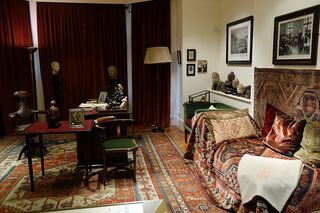Freudian Psychology
What's in a Psychotherapy Office?
Decorating the psychotherapy space.
Posted May 22, 2020 Reviewed by Jessica Schrader
We shape our buildings, and thereafter they shape us. —Winston Churchill
It's one of the very first questions the newly minted psychotherapist must answer: How do you decorate the therapy office? While the psychoanalysts of the mid-20th century often focused on these types of questions pertaining to the psychotherapy environment and "frame" (see, for instance, Langs, 1973), the contemporary psychotherapy literature offers little guidance on this issue.
In my own graduate school training, the only discussion had about the physical office arrangement was related to therapist safety. My well-intentioned professor, an expert on client violence in psychotherapy, suggested that the therapist sit closer to the door than the patient—to prevent possible harm. I was dissatisfied by this discussion, namely because it cast a negative light on psychotherapy patients and also because it said nothing of the very many other decisions that have to be made in relation to office décor.
For some, it seems, the question of how to decorate the psychotherapy office is an afterthought, or it is treated in the same casual manner as how one might decorate their own home. But the psychotherapy space is a sanctified one—at once a reflection of the therapist himself and an environment in which the privileged work of psychotherapy takes place. In my opinion, its design should be made with care and attention.
Below, I offer some thoughts on the design and décor of the psychotherapy space, with the particular aim of helping young therapists think about their office arrangements. I admit to being a psychotherapy traditionalist, and what is offered here are not rules but mere suggestions. Some experienced and respected therapists may disagree with some or all of these comments.
The Seating Arrangement
Since psychotherapy is conducted while seated, it could be said that the only necessary requirement for the office space is two chairs. However, some therapists have historically preferred that the patient sit, or lie, on a couch, owing to the psychoanalytic origins of psychotherapy.
I have found that many older patients expect to see a couch in the consulting room, while younger patients don't see it as a defining feature of the psychotherapy space, indicating that perhaps the trend has been away from the couch and toward two chairs. I retain a couch in my own office and find it to be a more comfortable and useful furnishing.
One should avoid an arrangement wherein the therapist sits in a comfortable or ornate chair and the patient sits in a chair of lesser quality or comfort. One notable departure from this suggestion exists in the office of the esteemed psychoanalyst Michael Eigen, who has his patients sit in a metal folding chair (Zimmerman, 2016).
The height of the chairs also matters. The therapist and patient should be able to easily make eye contact without a sense that the therapist is "looking down" at the patient. Positioning the chairs directly in front of each other may not be ideal; a slight angle is preferred to avoid a confrontational arrangement. In his work with schizophrenia patients, Arieti (1974) suggested that the therapist sit in a chair next to the patient rather than directly across from him—to assist in the development of an aligned, trusting relationship.
The distance between the therapist and the patient should ideally be a comfortable one for engaging in conversation—not too close nor too far. I suggest around six feet. The therapist should avoid an arrangement wherein he is sitting completely across the room from the patient at a distance of 10 or 12 feet. This may evoke a sense in the patient that the therapist wishes to distance himself from the patient's problems or experiences.
The Use of a Desk
The psychotherapist usually has a desk in the office to work on notes, use the computer, and stay organized. It is important here that the desk be arranged in a way so as to not interfere with the psychotherapy process.
Langs (1973) notes that "Some therapists conceal themselves behind the desk, thereby communicating to the patient their inappropriate need for protection from him" (p. 44). In my view, there is no excuse for the therapist who positions the desk in such a way. Such an arrangement is fit for accountants and attorneys, but not for the professional who deals most wholly with human emotional life.
The Coffee Table
Often, therapists position a small coffee or end table between themselves and the patient. The table serves as a place for the patients' personal belongings, such as their cellphone, car keys, etc., and also as a reminder of the appropriate and realistic boundaries between therapist and patient, though it is not essential.
Diplomas and Certificates
It is customary for therapists to hang some diplomas and certificates in their offices, though some therapists choose not to do so.
In my opinion, the therapist should avoid hanging or displaying too many certificates, especially if they are hung on the wall directly behind him. Such arrangements may reveal the therapist's own insecurities and need to be seen as "the powerful expert." My general advice is to hang a couple of the most important diplomas or certificates out of the patient's line of sight or to avoid hanging them altogether.
Personal Effects
There are varying opinions as to the appropriateness of personal belongings and effects in the psychotherapy space. While Freud is often cast inappropriately as a totally "blank slate," his office was filled with various knick-knacks and antiquities of personal interest. Here, anything is grist for the analytic mill.
However, caution should be exercised in displaying photographs directly related to the therapist's life, e.g., photos of family, spouse, pets, vacations, etc. As with anything located within the psychotherapy office, personal effects will evoke fantasies and feelings in both the patient and the therapist, and the latter must be aware of the implications of the arrangement himself.

I would also submit that therapists should avoid displaying expensive possessions in the psychotherapy space, particularly those therapists who work with underserved and underprivileged populations.
Calm, soothing artwork can be displayed to provide a positive distraction and respite from discussions on weighty issues. Landscapes of rolling hills and pastures are one suggestion. In my office, I have a painting of a large sailboat weathering the high seas.
Flowers and Plants
Freud suggested that therapists keep flowers in their offices, stating, "Flowers are restful to look at. They have neither emotions nor conflicts." This is, of course, a matter of personal preference. However, I have found that patients do enjoy the smell and sight of fresh flowers. The same goes for a fish tank. Maintaining a living, breathing organism in the office space gives it a sense of vitality.
Keeping artificial flowers, however, may not be advised. Even worse are dying flowers or a dirty fish tank.
The Tissue Box
It is advised that the therapist keep a box of tissues in the office. I recommend that they are kept within reach of the patient's location, so that the patient does not have to get up and walk across the room for them. Whether to hand the tissue box directly to the teary-eyed patient or to wait for him to reach for them himself is an interesting question, and one that is certainly ripe for analysis. Also, if there are tissues, there should be a wastebasket so that the patient can dispose of them.
Cleanliness and Organization
Therapists usually do a good job of keeping their offices neat and organized, though surprisingly I have seen some offices that are an utter mess. Such disorganization is likely to lower the patient's confidence in the therapist's competence and ability to remain mentally organized.
Conclusion
The space in which psychotherapy is provided is, in many respects, central to the therapy itself. Office décor and design reveal aspects of the therapist's own life and personality, and questions surrounding the physical space should be examined carefully, both by the therapist individually and within the context of the psychotherapy.
Author's note: A recent book by Sebastian Zimmerman, M.D., titled Fifty Shrinks, offers a rare look inside the offices of 50 different psychotherapists—including some prominent analysts like Otto Kernberg and Martin Bergmann. I consider it a must-read for anyone with an interest in the physical psychotherapeutic environment.
References
Arieti, S. (1974). The interpretation of schizophrenia. Basic Books.
Langs, R. (1973). The technique of psychoanalytic psychotherapy (Vol. 1). Aronson.
Zimmerman, S. (2016). Fifty shrinks (2nd ed.). Author.




